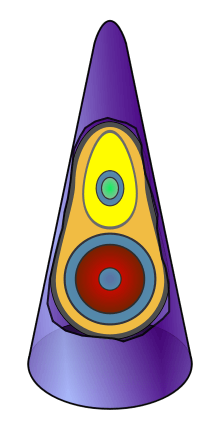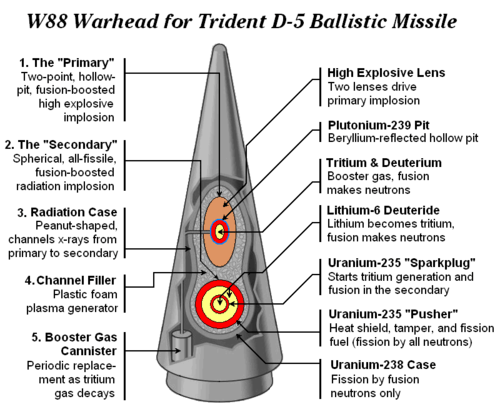W88

The W88 is a United States thermonuclear warhead, with an estimated yield of 475 kilotons[1] (kt), and is small enough to fit on MIRVed missiles. The W88 was designed at the Los Alamos National Laboratory in the 1970s. In 1999, the director of Los Alamos who had presided over its design described it as "the most advanced U.S. nuclear warhead."[2] As of 2014, the latest version is called the W88 ALT 370[3] and the first production unit is scheduled for December 2019.[4] The Trident II submarine-launched ballistic missile (SLBM) can be armed with up to 12 W88 warheads (Mark 5 re-entry vehicle) or 12 100 kt W76 warheads (Mark 4 re-entry vehicle), but it is limited to 8 warheads under the Strategic Offensive Reductions Treaty.
Design revelations
Information about the W88 has implied that it is a variation of the standard Teller–Ulam design for thermonuclear weapons.
In a thermonuclear weapon such as the W88, nuclear fission in the primary part causes nuclear fusion in the secondary part, which results in the main explosion. In 1999, a reporter for the San Jose Mercury News reported that the W88 had a prolate (egg- or watermelon-shaped) primary (code-named Komodo) and a spherical secondary (code-named Cursa) inside a specially-shaped radiation case (known as the "peanut" for its shape). A story four months later in The New York Times by William Broad reported that in 1995, a supposed double agent from the People's Republic of China delivered information indicating that China knew these details about the W88 warhead as well, supposedly through espionage (this line of investigation eventually resulted in the abortive trial of Wen Ho Lee). If these stories are true, it would indicate a variation of the Teller-Ulam design which would allow for the miniaturization required for small MIRVed warheads.[5][6][7]
The value of a prolate primary lies apparently in the fact that a MIRV warhead is limited by the diameter of the primary — if a prolate primary can be made to work properly, then the MIRV warhead can be made considerably smaller yet still deliver a high-yield explosion — a W88 warhead manages to yield up to 475 kt with a physics package 68.9 in (1.75 m) long, with a maximum diameter of 21.8 in (0.55 m), and weighing probably less than 800 lb (360 kg).[1] Smaller warheads can allow a nation to fit more of them onto a single missile, as well as improve in more basic flight properties such as speed and range.
The calculations for a nonspherical primary are apparently orders of magnitude harder than for a spherical primary. A spherically symmetric simulation is one-dimensional, while an axially symmetric simulation is two dimensional. Simulations typically divide up each dimension into discrete segments, so a one-dimensional simulation might involve only 100 points, while a similarly accurate two dimensional simulation would require 10,000. This would likely be the reason they would be desirable for a country like the People's Republic of China, which already developed its own nuclear and thermonuclear weapons, especially since they were no longer conducting nuclear testing which would provide valuable design information.[8]

See also
References
- 1 2 "The W88 Warhead".
- ↑ Harold M. Agnew, "Letter: Looking for Spies in Nuclear Kitchen", Wall Street Journal (17 May 1999), p. A27.
- ↑ "W88 warhead program performs successful tests". Sandia Labs News Releases. Sandia Corporation. October 28, 2014.
- ↑ "Fiscal Year 2016 Stockpile Stewardship and Management Plan" (PDF). National Nuclear Security Administration. United States Department of Energy. March 2015. p. 2-20.
- ↑ Dan Stober and Ian Hoffman, A convenient spy: Wen Ho Lee and the politics of nuclear espionage (New York: Simon & Schuster, 2001). ISBN 0-7432-2378-0
- ↑ Howard Morland, "The holocaust bomb: A question of time" (February 2003)
- ↑ William J. Broad, "Spies versus sweat, the debate over China's nuclear advance," New York Times (7 September 1999), p. 1.
- ↑ Christopher Cox, chairman, Report of the United States House of Representatives Select Committee on U.S. National Security and Military/Commercial Concerns with the People's Republic of China (1999), esp. Ch. 2, "PRC Theft of U.S. Thermonuclear Warhead Design Information".
External links
- Nuclear weapons archive on the W88
- Globalsecurity.org on the W88
- "Department of Energy, FBI, and Department of Justice Handling of the Espionage Investigation into the Compromise of Design Information on the W-88 Warhead" statement by U.S. Senate Governmental Affairs Committee heads.
- PRC theft of U.S. thermonuclear warhead design information
- Report on the Government's Handling of the Investigation and Prosecution of Dr. Wen Ho Lee